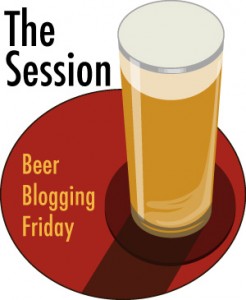
The June Session (#64) comes to us from the Beer Babe and without further ado….
“What is the one beer style usually makes up the first position in the sample flight, but yet is usually the one that we never get really excited about? The Pale Ale.
While this style serves as the foundation to its big-hoppy-brother the India Pale Ale, lately “Pale Ale” has become a throwaway term. I hear bartenders and servers using it to describe everything from Pilsners to unfiltered wheat beers (I wish I was kidding).
Whether American (typically a bit hoppier) or English (a little more malty), these brews can be complex, interesting and tasty, and are all too often fast-forwarded through in a tasting or left as the “eh, guess I’ll have a pale ale” decision.
Your mission – if you choose to accept it – it so seek out and taste two different pale ales. Tell us what makes them special, what makes them forgettable, what makes them the same or what makes them different. Then, share it with us.”
Delving into the world of pale ale actually brought up more questions than answers as I drank, researched, wrote and then drank some more.
For this session, I started with Ballast Point and their (as I sip between keystrokes) pale ale. Which, to me, tastes more in the region helles / kolsch than pale ale. (1) It is quite grain forward and even it’s light orange to yellow color hints that the name on the label may be a misnomer.
QUESTION # 1
How can a brewery make an IPA like Sculpin and have a pale ale be nearly hop less?
Back in 2010, when I first had this pale (2), I rated it a 3 out of 5 on Ratebeer which is about where I would put it again in 2012 as long as I was rating it based on it’s kolschy-ness. Looking at the past review made me dig deeper into my recorded history with pales. I started into the stats of the matter and found that pales were my 4th most rated beer style. But that it was laughably behind the # 1. IPA. And wasn’t even close to DIPA’s and Imperial IPAs either. And it was barely holding off the hard chargin # 5 style, saison.
QUESTION # 2
Why is it so easy to find bombers of stouts and IPA’s and not pale ales?
So I finished off my Ballast Point and headed to the standard bearer of the style. The one with the familiar green label. Sierra Nevada. And the mild citrusy bitterness that I seem to always return to every 3 or 4 months. In my Ratebeer review (3), I said “…pale before pale had to be uber hoppy. Nice balance here. …. Flavor is simple. A great anytime beer.”
Drinking it again, I have to agree with my younger self. The beer hints at bitterness, subtley nods towards the citrus and is a near perfect bronze color. I would still pick this over Torpedo and Hoptimum any day of the week.
QUESTION # 3
Why do IPA’s get killer names like Hopportunity Knocks or Hoptimus Prime and pale ales either go unnamed or have much more staid monikers like Dales?
Lastly, I want to talk about a local brewer. El Segundo Brewing (4). Their 1st year anniversary batch was a DIPA but their bread and butter are pales. And they do a damn fine job with them whether they be Summit based, Citra or even with sage. Heck (5) one of their IPA’s is a wheat version which is hoppy, for sure, but I would consider it more a pale than an IPA.
Question # 4
Shouldn’t pale ales be part of a breweries regular line-up instead of an IPA?
In the end, the pale like other styles that are not in the “cool” clique at the moment can range from A to Z and deserves more than a cursory glance.
(1) Checking in Ratebeer, I find that it is not even labeled as a pale but rather a kolsch.
(2) Back when it was called Yellowtail
(3) Again in 2010, I must have drunk a lot of beer that year.
(4) Literally across the street from the now partially owned by Gene Simmons Rock and Brews. A great L.A. craft beer hang out.
(5) Must stop cursing.

